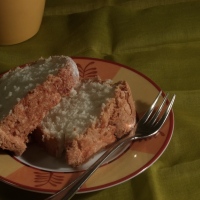Il mio lievito madre, pongy, è impazzito: forse il caldo influisce anche sulla temperatura interna del frigorifero? Probabilmente si, ma a dire il vero qui in campagna, dove ho la fortuna di essere, in cucina ho mediamente 22 gradi……insomma non so perchè, ma è talmente attivo che se ne è uscito dal barattolo chiuso ermeticamente…….è felice insomma e se ne va un po’ a zonzo!
Ho deciso di preparare la focaccia pugliese perchè mi stavo organizzando per un barbecue con amici e mi sembrava perfetta insieme alla grigliata di pesce e alle melanzane alla parmigiana. Non ho resistito, però, ad effettuare qualche modifica negli ingredienti……quindi non è proprio una vera focaccia pugliese, ma ve la consiglio vivamente, è buonissima e molto facie.
Ingredienti per una focaccia per 6-8 persone
- 150 gr di lievito naturale o 15 g di lievito di birra
- 350 gr di semola rimacinata
- 150 g di manitoba
- 350 gr di acqua o un pochino di più se la manitoba la richiede
- 1 cucchiaino di zucchero
- 13 gr di sale
- 25 gr di olio extra vergine di oliva
- q.b. di pomodorini secchi sott’olio
- olive snocciolate se volete, io non le ho messe perchè non le avevo……
- origano q.b.
- Rinfrescate il lievito madre e lasciatelo a temperatura ambiente fino a quando non raddoppia (2-3 ore circa).
- Sciogliete il lievito madre raddoppiato, o il lievito di birra, in metà dell’acqua leggermente tiepida.
- Aggiungete lo zucchero e l’olio: impastate brevemente per farli assorbire.
- Aggiungete le farine e impastate con il gancio se usate la planetaria (o in una ciotola se impastate a mano).
- Aggiungete il resto dell’acqua poco alla volta, tenetene un fondo per sciogliervi il sale che sarà l’ultimo ad essere aggiunto all’impasto.
- Lavorate fino ad avere una massa liscia ed elastica.
- A questo punto riibaltate la pasta sulla spianatoia dandole una forma a palla (anche se l’impasto è un po’ appiccicoso)
- Ora: se state usando lievito madre fare partire la lievitazione a temperatura ambiente e dopo circa un’oretta mettetelo in frigorifero per almeno 8 ore coperto da pellicola e ben oliato..
- Se state usando lievito di birra lasciate lievitare a temperatura ambiente fino al raddoppio (circa 3 ore)
- Se siete in inverno, la temperatura della cucina potrebbe essere troppo bassa per la lievitazione, per cui vi consiglio di lasciare lievitare nel forno spento con la sola lucina accesa che riscalderà l’aria quanto basta.
- Togliete l’impasto con il lievito madre dal frigorifero e portatelo a temperatura ambiente (ci vorrà un’oretta) oppure prendete quello lievitato con il lievito di birra e ribaltatelo in una teglia unta con abbondante olio extravergine d’oliva.
- Senza schiacciare troppo e usando i polpastrelli cercate di allargare l’impasto senza tirarlo fino a coprire l’intera superficie della teglia.
- Lasciate lievitare per almeno altre 2 ore.
- Ungere la superfice della focaccia con altro olio.
- Preriscaldate il forno a 220° e abbassatelo a 200° appena infornate.
- Cuocete fino a coloritura (circa 20 minuti).
- A questo punto disponete i pomodorini secchi sulla superficie e aggiungete le olive: salart e cospargete di origano.
- Cuocete gli ultimi 5 minuti cercando di tenere la porta del forno socchiusa, per fare uscirei un pò di umidità residua e aumentare la croccantezza della focaccia.
- Una volta sfornata, togliete dalla teglia e servite!!
ENGLISH VERSION
My yeast, pongy, has got crazy, maybe the heat also affects the internal temperature of the refrigerator? Probably yes, but to tell the truth here in the countryside, where I’m lucky to be, in the kitchen I average 22 degrees …… in short, I do not know why, but it is so active that it came out of the jar tightly closed. In short …… is happy and goes a bit ‘a stroll!
I decided to make this focaccia because I was planning for a barbecue with friends and it seemed perfect with the grilled fish and eggplant parmigiana.
Ingredients: serves 6-8 people
- 150 grams of natural yeast or 15 g of chemical yeast
- 350 grams of semolina
- 150 g of Manitoba floor
- 350 grams of water or a little more if the Manitoba requires it
- 1 teaspoon sugar
- 13 grams of salt
- 25 g of extra virgin olive oil
- q.b. dried tomatoes in oil
- pitted olives if you want, I do not put them because I had not ……
- oregano to taste
- Refresh the natural yeast and leave at room temperature until doubled (2-3 hours).
- Dissolve the yeast doubled, or the chemical yeast in half the water slightly warmed.
- Add sugar and oil: mix briefly to absorb them.
- Add flour and knead with the hook if you use the food processor (or in a bowl if kneading by hand).
- Add the remaining water a little at a time, tap and a fund to dissolve the salt that will be the last to be added to the dough.
- Knead until you have a smooth and elastic dough.
- At this point put the dough on a work surface giving it a shape of a ball (even if the dough is a bit ‘sticky)
- Now, if you’re using natural yeast let it rise at room temperature about an hour or so then put it in the refrigerator for at least 8 hours, covered with foil and well oiled .
- If you are using chemical yeast let it rise at room temperature until doubled (about 3 hours)
- If you are in winter, the temperature of the kitchen might be too low for leavening, so I suggest you let it rise in the oven with only the small light on.
- Remove the dough with natural yeast from the refrigerator and bring it to room temperature (it will take about an hour) or take the one leavened with chemical yeast and flap in a greased pan.
- Without crushing it too much and using the fingertips try to expand it, without stretching the dough until it covers the entire surface of the pan.
- Let it rise for at least another 2 hours.
- Coat the surface of the focaccia with some more oil.
- Preheat oven to 220 C degrees and before baking, turn it down to 200 ° C.
- Cook until coloring (about 20 minutes).
- At this point put the dry tomatoes on the surface and add the olives: season with salt and sprinkle with oregano.
- Cook the last 5 minutes trying to keep the oven door open, to go out a bit of residual moisture and increase the crispness of the cake.
- Once baked, remove from the pan and serve!















